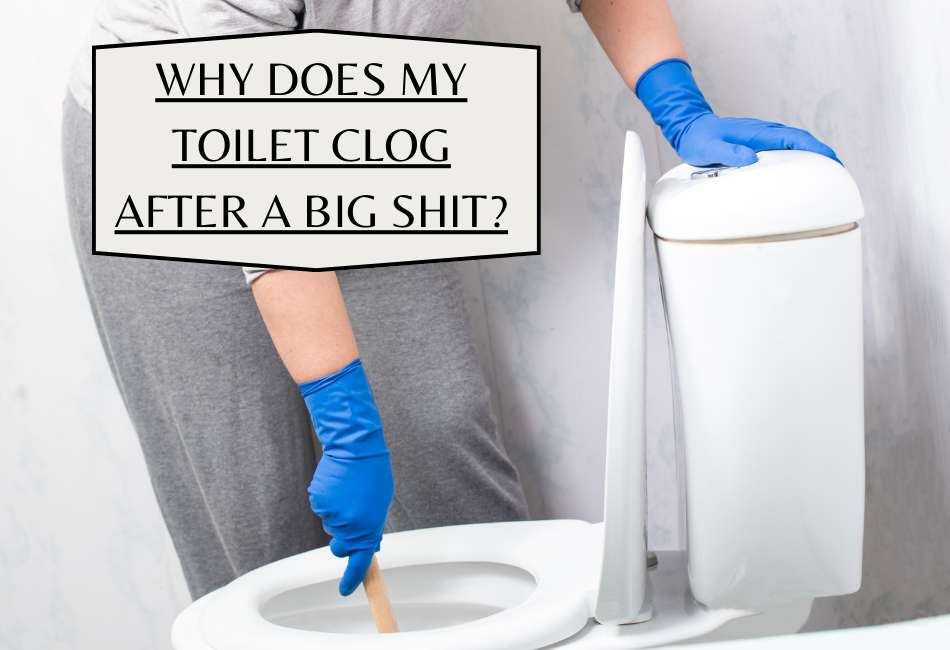Isn’t it a common yet frustrating scenario when a large bowel movement leads to a clogged toilet?
Not only does this pose an inconvenience, but it also can create an embarrassing situation, particularly when you’re a guest at someone else’s home or a public facility.
Understanding the reasons behind this common problem and how to fix it can save you from such uncomfortable instances.
This blog post aims to shed light on the reasons why toilets get clogged after a large poop and, more importantly, how to deal with it effectively.
Stick around as we delve into this topic, equipping you with practical solutions for an all-too-common problem.
1. Inadequate Flushing Power
In my experience, adequate flushing power is fundamental in preventing toilet clogs.
How many times have you flushed only to find, to your dismay, that the waste has not been flushed away completely?
Importance of Sufficient Flushing Power
The importance of sufficient flushing power cannot be overstated. When the toilet has enough power to flush, it can easily push waste down the pipe, preventing buildup and subsequent clogs.
Low Water Levels and Inefficient Flush Mechanisms
I remember when my toilet’s water level was unusually low, causing inefficient flushes.
This is often a result of issues with the toilet’s design or mechanism, which, if not addressed, can lead to frequent clogs.
Outdated or Low-flow Toilet Models
Also, if you’re using an outdated or low-flow toilet model, like I did in my old apartment, it may not have the necessary flushing power.
These models are designed to conserve water but can sometimes fail to remove waste, making them more prone to clogs effectively.
Addressing Flushing Power Issues
Addressing these flushing power issues became a priority for me. Not only did it save me from potential embarrassment, but it also maintained a clean and hygienic bathroom environment.
2. Insufficient Water Levels
Low water levels in your toilet bowl are a sneaky culprit behind clogs.
Contribution to Clogs
Insufficient water levels can make it difficult for waste to be flushed away properly, leading to – you guessed it – clogs.
Causes of Low Water Levels
Based on what I’ve learned, low water levels can be due to faulty fill valves, flapper problems, or even an incorrect float height.
I remember having to replace the fill valve in my toilet once – it was a bit of a hassle but worth it.
Solutions to Address and Fix Low Water Levels
Fortunately, fixing these issues isn’t as daunting as it might seem. You can adjust the float to increase water levels or replace the faulty fill valve or flapper.
Trust me, taking the time to address these issues will save you from many future toilet troubles!
3. Faulty Toilet Design
Faulty toilet designs are another common culprit behind frequent clogs. I had a toilet once that had a narrow trapway, the part of the toilet through which water and waste exit.
This design flaw led to frequent clogs since the narrow passage made it hard for waste to pass through effectively. It might be worth considering an upgrade if you have a similar issue.
More Prone to Clogs
Certain toilet designs are inherently more prone to clogs. For example, toilets with low flush power or a small trapway diameter can cause issues, as they may not effectively remove waste.
I remember my old toilet, having both issues, drove me up the wall with incessant clogs!
Design Flaws Hindering Waste Removal
The design of the toilet can significantly affect its function. Some toilets have trapways designed with multiple bends, which, while stylish, can impede the smooth passage of waste.
I learned this the hard way when I bought a chic, modern toilet only to find it clogging more often than not.
Consideration of Upgrading
Upgrading your toilet can be a game-changer. When I replaced my old, poorly designed toilet with a newer model featuring a larger, straighter trapway and higher flushing power, the clogs became a thing of the past.
It was an investment, but it paid off in the long run in terms of convenience and peace of mind.
4. Excessive Toilet Paper Usage
We often underestimate how excessive toilet paper usage can lead to clogs. I have seen this happening in my own home.
When we overuse toilet paper, it creates a load that’s too much for the toilet to handle, leading to a clog.
Leading to Clogs
Overusing toilet paper is a common mistake. I remember when my kids were young, and they’d use half a roll per visit, leading to frequent clogs.
Excessive toilet paper doesn’t dissolve fast enough and can quickly build up, especially in toilets with low flushing power.
Proper Toilet Paper Usage
It’s crucial to use toilet paper wisely to avoid clogs. I’ve taught my family only to use what’s necessary – usually, a few squares are sufficient.
It took some time for them to adapt, but it drastically reduced the frequency of clogs.
Alternatives to Toilet Paper
There are alternatives to consider if toilet paper usage is causing problems. Switching to less-dense toilet paper, which breaks down more easily, can be one solution.
Another alternative is using a bidet, which I installed in my bathrooms. Not only did the bidet reduce the reliance on toilet paper, but it also proved to be a more hygienic and environmentally friendly solution.
5. Foreign Object Obstruction
Unforeseen Culprits
Believe it or not, foreign objects are one of my home’s strangest causes of toilet clogs. These are items that certainly have no business being in a toilet.
I’ve found everything from action figures to toothbrushes lodged in the pipe, causing blockage. It’s a wild world out there, my friends.
Common Unintentional Intruders
You’d be surprised how frequently everyday household items get into the toilet, particularly if you have small children or pets.
In the past, toys, sanitary products, cotton swabs, and even dental floss have been known to cause clogs. And believe me, it’s no fun fishing those out!
Preventative Measures
I suggest adopting some ground rules to prevent foreign objects from ending up in your toilet. In my house, we make a point of keeping small items away from the bathroom.
I even installed a small bathroom essentials shelf away from curious little hands. It’s also important to reinforce that the toilet isn’t a trash bin.
6. Septic System Issues
The Hidden Problem
Sometimes, the problem lies not with the toilet but the septic system itself. I’ve had my fair share of septic system issues, and let me tell you, they’re a nightmare.
If your septic tank is full or malfunctioning, it can lead to frequent and stubborn toilet clogs.
A Full Tank’s Impact
When a septic tank reaches capacity, it can’t process waste properly, causing it to go back into the toilet. I remember the first time this happened to me — not an episode I’d like to relive.
Monitoring your septic system and having the tank pumped regularly is important.
Regular Maintenance is Key
Like anything else around the house, regular septic system maintenance goes a long way.
It’s recommended to have it inspected by a professional every three years and pumped every three to five years.
Trust me, a little prevention will save you a lot of trouble. Remember, an ounce of prevention is worth a pound of cure!
Professional Plumbing Assistance
The Necessity of Professional Help
There are times when the stubbornness of a clog is a sign that you need to call in the professionals.
I remember a time when I had tried everything, plunged until my arms were sore, and used every home remedy I could find, and still, that clog refused to budge.
I finally swallowed my pride and called a plumber, only to find out the problem was way beyond my skill set – a tree root had infiltrated my pipes!
Sometimes, it’s not just about unclogging the toilet but recognizing when the problem is bigger than you.
Signs You Need a Plumber
There are some telltale signs that a plumbing issue is serious. Persistent clogs, slow drainage, gurgling sounds from your pipe, and water back into other drains are all warning signals.
If you experience any of these and your regular fixes aren’t doing the trick, it’s time to call a pro.
The Role of Plumbers
Plumbers are trained to diagnose and fix plumbing problems beyond regular homeowners’ capabilities.
They have the tools, knowledge, and experience to handle complex issues. Not only can they effectively unclog stubborn toilets, but they can also identify and address underlying problems that could be causing recurrent clogs.
Conclusion
We’ve covered a lot of ground in this post, from common clogging culprits like too much toilet paper and non-flushable items to more complex issues like septic system malfunctions.
And let’s not forget the importance of preventative measures and knowing when to call in professional help.
Remember, being proactive can save you a lot of hassle. Set ground rules for what can go down the toilet, keep small items out of reach and monitor your septic system regularly. Trust me, your future self will thank you.
Don’t let a stubborn clog get you down. Try these fixes, and don’t be afraid to call in the pros when necessary.
Remember, everyone deals with a troublesome toilet at some point. We’re all in this together!

